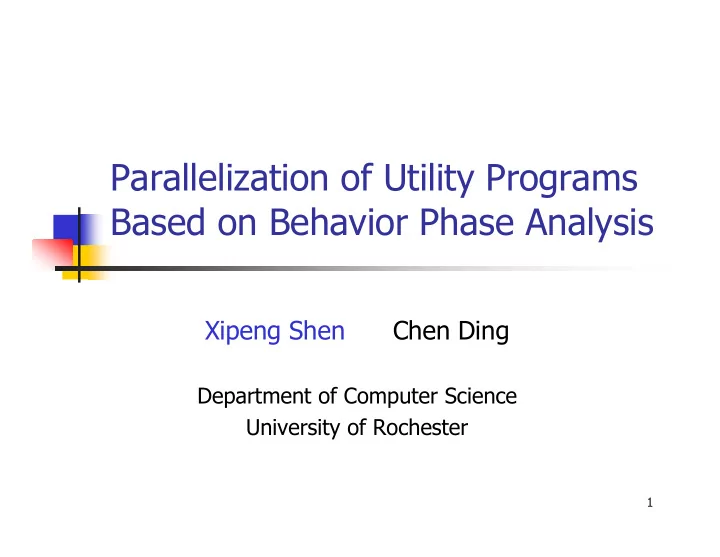

Parallelization of Utility Programs Based on Behavior Phase Analysis Xipeng Shen Chen Ding Department of Computer Science University of Rochester 1
Motivation Multi-core is coming to personal computers Many programs, especially those run on past personal computers, are sequential programs Automatic parallelization is the path of least resistance 2
Utility Programs A class of dynamic programs which take a group of requests and serve them one by one Examples Compilers, interpreters, compressions, transcoding utilities, ... GNU C compiler (Gcc) The compilation of a function is a phase 3
Challenges Dynamic data (access) Dynamically allocated data structures One or more levels of indirections Complex control flow Input-dependent execution paths Many (recursive) function calls More difficult to analyze and parallelize than scientific programs 4
Opportunities Different phase instances operate on different data, thus have few data dependences between them Recently we found a way to detect the phase boundaries Can we automatically parallelize those programs at the phase level? 5
Overview Objective: to preliminarily check the feasibility of parallelizing utility programs at phase level without special hardware support Technology Phase detection Dependence detection Program transformation Evaluation Summary 6
Behavior Phase Detection Key idea: active profiling Use regular input to trigger repetitive behavior Filtering dynamic basic block trace based on frequency and recurring distance Use real input to verify phase boundaries *Refer to “ Shen et. al., TR 848, CS, U of Rochester, 2004 ” 7
Phase-based Parallelization Process-based parallelization Separate address space Each process executes one or a group of phase instances 8
Phase-Dependence Detection Trace memory accesses in profiling runs Detect different kinds of dependences anti- and output dependences can be ignored because of separate address space Classify flow dependences into removable and non-removable types 9
Flow Dependence Removable flow dependence Memory reuses Implicit initialization Byte operations 10
Memory Reuses Two objects are allocated to the same memory location in different part of the execution. 11
Implicit Initialization NODE* xlevel(NODE* expr){ if (++xltrace<TDEPTH){ ... } - - xltrace; } *code fragments from SPEC2K/LI 12
Byte Operation char * buf; ... buf[i] = 0; // byte operation lda s4, -28416(gp) // load array base address addq s4, s0, s4 // shift to the target array element ldq u v0, 0(s4) // load a quadword from the current element mskbl v0, s4, v0 // set the target byte to 0 by masking stq u v0, 0(s4) // store the new quadword to the array *code fragments from SPEC2K/Parser 13
Program Transformation We parallelize programs by hand at phase boundaries based on the information provided by the automatic tool A fully automatic tool would include automatic parallelization with run-time support to guarantee correctness and rollback when necessary Currently being studied 14
Evaluation (4-CPU Xeon 2GHz) Gzip Parser 1.5 Speedup times 1 0.5 0 1 2 4 8 -0.5 Process Number 15
Evaluation (16-CPU Sunfire Sparc V9 1.2 GHz) Gzip Parser 14 Speedup times 12 10 8 6 4 2 0 1 2 4 8 16 32 Process Number 16
Summary A preliminary exploration on the coarse- grain parallelization of utility programs based on behavior phases Fully automatic system remains our future work 17
The End Thanks! 18
Recommend
More recommend